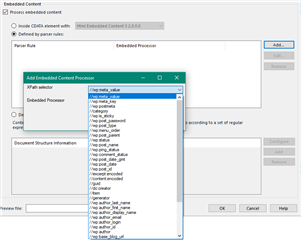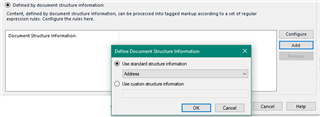Is there any improvement in Studio 2021 regarding processing of embedded elements (html and text)? The way we select both embedded html and text when prepping xmls in the new version of Studio?
Is there any improvement in Studio 2021 regarding processing of embedded elements (html and text)? The way we select both embedded html and text when prepping xmls in the new version of Studio?
An excellent question, and one Patrik Mazanek would be most suited to answer. But I'll have a go and he can add anything I may have missed.
First of all perhaps review this article that covers where the handling of embedded content is possible:
https://multifarious.filkin.com/2020/09/20/psst-wanna-know-a-few-more-things-about-file-types/
Then, let's look at the XML2 filetype in Trads Studio 2021. Embedded Content settings are on this page:

With this there are three ways to define where embedded content comes from and two ways to handle it.
Ways to define it:
1. and 3. have been possible for some time. 2. is new and this is an excellent enhancement. You can now define different rules for each parser rule:

Ways to handle it:
You either choose to process the embedded content using another filetype from the Embedded Content Processor list... the defaults:

Or what you see in here:

You can customise these and have as many versions as you like.
OR... you can use regular expression rules as you used to be able to do with the old legacy XML filetype:

These are getting close to covering any scenario you might have these days.

An excellent question, and one Patrik Mazanek would be most suited to answer. But I'll have a go and he can add anything I may have missed.
First of all perhaps review this article that covers where the handling of embedded content is possible:
https://multifarious.filkin.com/2020/09/20/psst-wanna-know-a-few-more-things-about-file-types/
Then, let's look at the XML2 filetype in Trads Studio 2021. Embedded Content settings are on this page:

With this there are three ways to define where embedded content comes from and two ways to handle it.
Ways to define it:
1. and 3. have been possible for some time. 2. is new and this is an excellent enhancement. You can now define different rules for each parser rule:

Ways to handle it:
You either choose to process the embedded content using another filetype from the Embedded Content Processor list... the defaults:

Or what you see in here:

You can customise these and have as many versions as you like.
OR... you can use regular expression rules as you used to be able to do with the old legacy XML filetype:

These are getting close to covering any scenario you might have these days.
